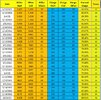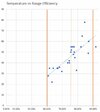So I recently got a long range mode Y and my commute is from around riverside to barstow, 75 miles one way. One the way to work, its mostly uphill and it consumes lot of energy and my range goes from 265 mi to 160 mi, when I arrive to work. And when I come back home I am left with around 7mi. It seems like The battery is draining a lot more than it should?
I drive around the speed limit, 5-10 mph over max, mostly on autopilot. Should I be concerned about this issue?
I drive around the speed limit, 5-10 mph over max, mostly on autopilot. Should I be concerned about this issue?




